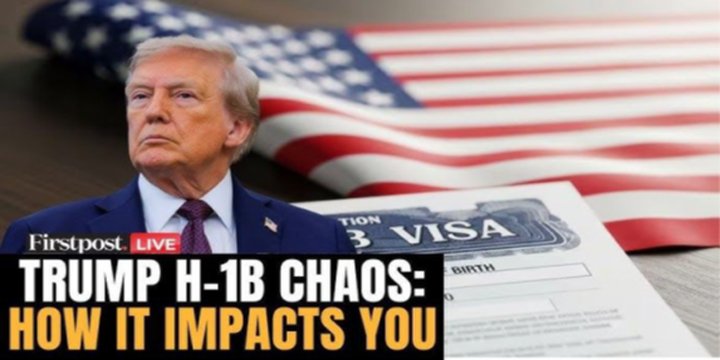H1B VISAS, INDIAN WORKERS & CHANGING IMMIGRATION DISCOURSE
Context: The Trump administration has imposed a $100,000 annual fee on each H-1B visa. This move significantly affects Indian tech workers, who constitute over 70% of H-1B visa holders, and has reignited the debate on immigration, protectionism, and skilled foreign labour in the United States.
WHY IN NEWS?
- From September 21, 2025, companies hiring foreign talent under the H-1B visa program in the US must pay $100,000 annually per visa.
- This change is expected to heavily impact Indian professionals, who form the majority of H-1B visa holders.
- It aligns with the Trump administration’s broader agenda of restrictive immigration policies, justified on the grounds of protecting American jobs.
- The move is part of a larger ideological battle within the US around skilled immigration, wage depression, and the future of global talent mobility.
WHAT IS H1B VISA PROGRAM?
- H-1B is a non-immigrant visa that allows US employers to temporarily hire foreign workers in specialty occupations, especially in STEM (Science, Technology, Engineering, and Math) fields.
- The program is capped at 85,000 new visas annually:
- 65,000 regular H-1B cap
- 20,000 for advanced degree holders from US institutions
- The visa is usually valid for 3 years, extendable to 6 years.
DETAILS OF THE NEW POLICY
- The Trump administration has imposed:
- A $100,000 annual fee for every H-1B worker employed.
- Previously, filing costs ranged from $1,500 to $6,000 per visa, depending on company size and legal compliance.
Why It’s a Game Changer
- It disincentivizes companies—especially tech firms—from hiring foreign workers.
- Smaller companies and Indian IT firms like Infosys and TCS may reduce or halt H-1B recruitment.
- Major shift from policy reform to prohibitive economic barriers.
INDIA’S DOMINANCE IN H1B VISA PROGRAM
| Country of Birth | Share of H-1B Approvals |
| India | 70–74% (since 2015) |
| China | 12–13% |
| Others | <15% combined |
Indian tech workers have been the backbone of US tech firms, working in roles from software development to AI research.
TRUMP ADMINISTRATION’S JUSTIFICATION
- Commerce Secretary Howard Lutnick called the H-1B program a “scam” in an August 2025 Fox News interview.
- Claimed it undercuts American workers’ wages:
- “Why are we doing that? It’s like picking the bottom core.”
- Echoes long-held nativist Republican positions that:
- Foreign workers are taking jobs from Americans.
- Immigration leads to wage depression and higher unemployment for US citizens.
WAGE DATA (FY 23)
| Salary Bracket (USD) | Share of Indian H-1B Approvals |
| Below $100,000 | ~70% |
| $100,000–$150,000 | ~25% |
| Above $150,000 | ~5% |
- Median salary for US IT professionals: $104,420 (May 2023, US Bureau of Labor Statistics)
- Critics argue Indian H-1B hires are underpaid relative to market standards.
- Supporters say wages are market-driven, and the skills gap necessitates foreign hiring.
US IMMIGRATION DISCOURSE
- Immigration is now one of the top political issues in the US.
- 14.6% of voters considered it the most important issue in 2024 (YouGov poll).
- Up from just 2.1% in 2012.
- Trump’s narrative:
- Framed low-skilled and now skilled immigration as threats to American livelihoods.
- Echoes his earlier “Mexicans stealing jobs” rhetoric—now targeted at Indian tech workers.
SKILLED WORKFORCE REALITIES
- India and China dominate global STEM talent.
- STEM graduates (2020, CSET data):
- China: 3.57 million
- India: 2.55 million
- US: 820,000
- Industry insiders argue:
- H-1B is essential to bridge US skill shortages, especially in emerging fields like AI, robotics, and semiconductors.
- Restrictions may lead to outsourcing or talent shifting to Canada, Europe, or Australia.
- STEM graduates (2020, CSET data):
ABANDONING REFORM: TRUMP’S H1B STRATEGY
Earlier Reform Proposals (2017–2020):
- Restrict intake to higher-paying positions.
- Change lottery to favor salary-based selection.
- Proposals shelved under the Biden administration.
Current Strategy (2025):
- No structural reform → Instead, impose a massive fee to deter hiring.
- $100,000/year fee = De facto cap without changing laws.
- Applies across the board → affects students, early-career professionals, and mid-level workers.
IMPACTS ON INDIA
Economic Impact:
- Indian IT companies may:
- Cut back on H-1B hiring
- Increase offshoring
- Shift operations to Canada, Europe
- Sectors affected:
- Technology
- Consulting
- Startups
- Higher education (student-to-worker pipeline)
Strategic Concerns:
- India’s people-to-people ties with the US weaken.
- Visa restrictions + trade tariffs (like those from August 2025) signal a hostile US policy environment.
IMPACT OF THE FEE HIKE
- HIRING PATTERNS MAY ALTER.
- American Cos. may opt for more offshoring to India. This can increase economic activities in India. (particularly tech startups)
- Nearshoring can also take place and business operations can be shifted to nearby countries like Mexico & Canada.
- LOCAL HIRING CAN GO UP.
- STOCK MARKET VOLATILITY.
- BRAIN DRAIN FROM INDIA WILL BE REDUCED.
Note: Connect with Vajirao & Reddy Institute to keep yourself updated with latest UPSC Current Affairs in English.
Note: We upload Current Affairs Except Sunday.

